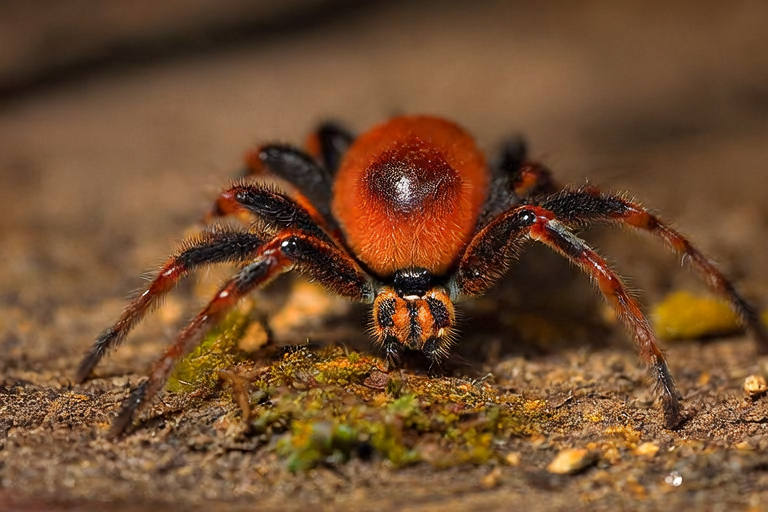Tarantula Spiders as Pets: A Unique and Responsible Choice
Tarantulas are one of the most fascinating and unique pets you can choose to have. For those who are bold and responsible, they make an excellent choice. They are not for everyone, but for the right person, they can be a wonderful addition to your home.
Basic Characteristics of Tarantulas
Tarantulas are large spiders that can grow up to 10 inches in length, with some species being much larger. Their colors vary depending on the species, ranging from dark brown or black to bright blues and oranges. Some species also have vibrant patterns on their legs and bodies. Tarantulas are generally docile and do not seek out human contact, but they can be quite active and interesting to watch.
Special Environment Setting for Tarantulas
Tarantulas require a specific environment to thrive. The temperature should be kept between 75-85 degrees Fahrenheit during the day and 65-75 degrees at night. Humidity levels should be maintained between 60-80%. The enclosure should be large enough for the tarantula to move around comfortably, with plenty of hiding spots and climbing structures. The substrate should be moistened slightly to help maintain humidity levels.
Feeding Tarantulas
Tarantulas are carnivorous and feed on live insects such as crickets, mealworms, and dubia roaches. It is important to offer appropriately sized prey to avoid injuring the tarantula. Tarantulas typically eat once every few days, but this can vary depending on the individual spider and its environment. It is also important to provide clean water in a shallow dish for hydration.
Interacting with Tarantulas
When handling tarantulas, it is important to be gentle and careful. Tarantulas can become stressed if handled too roughly, which can lead to molting problems or even death. It is best to handle them only when necessary, such as for cleaning the enclosure or moving them to a new home. Some people find it fun to watch their tarantulas hunt and eat prey, while others enjoy observing their behavior and interactions with their surroundings.
Buying and Caring for Tarantulas
When buying a tarantula, it is important to research different species and choose one that is appropriate for your level of experience. Some species are more docile than others, making them better suited for beginners. It is also important to purchase from a reputable breeder or pet store to ensure that the tarantula is healthy and properly cared for. Once you have your tarantula, it is important to provide proper care, including a suitable environment, regular feeding, and routine maintenance of the enclosure.
Unique Features of Tarantulas as Pets
Tarantulas are one of the most unique pets you can own. They are fascinating creatures that are easy to care for, but they require a certain level of responsibility and commitment. For those who are willing to put in the effort, they can be a rewarding and enjoyable pet. They are relatively low-maintenance, requiring minimal interaction, and they do not take up much space. However, they do require a specific environment and diet to thrive, so it is important to do your research before bringing one home.
Behavioral Characteristics of Tarantulas
Tarantulas are generally docile and do not seek out human contact, but they can be quite active and interesting to watch. They spend most of their time in their burrows or hiding spots, but they will come out to explore or hunt for food. Some species are more active than others, and some may even be more aggressive. It is important to research the specific species you are interested in to understand its behavior and needs.
Environmental Needs of Tarantulas
Tarantulas require a specific environment to thrive. The temperature should be kept between 75-85 degrees Fahrenheit during the day and 65-75 degrees at night. Humidity levels should be maintained between 60-80%. The enclosure should be large enough for the tarantula to move around comfortably, with plenty of hiding spots and climbing structures. The substrate should be moistened slightly to help maintain humidity levels. It is also important to provide clean water in a shallow dish for hydration.
Dietary Requirements of Tarantulas
Tarantulas are carnivorous and feed on live insects such as crickets, mealworms, and dubia roaches. It is important to offer appropriately sized prey to avoid injuring the tarantula. Tarantulas typically eat once every few days, but this can vary depending on the individual spider and its environment. It is also important to provide clean water in a shallow dish for hydration.
Handling and Interacting with Tarantulas
When handling tarantulas, it is important to be gentle and careful. Tarantulas can become stressed if handled too roughly, which can lead to molting problems or even death. It is best to handle them only when necessary, such as for cleaning the enclosure or moving them to a new home. Some people find it fun to watch their tarantulas hunt and eat prey, while others enjoy observing their behavior and interactions with their surroundings.
Choosing and Caring for Tarantulas
When buying a tarantula, it is important to research different species and choose one that is appropriate for your level of experience. Some species are more docile than others, making them better suited for beginners. It is also important to purchase from a reputable breeder or pet store to ensure that the tarantula is healthy and properly cared for. Once you have your tarantula, it is important to provide proper care, including a suitable environment, regular feeding, and routine maintenance of the enclosure.
